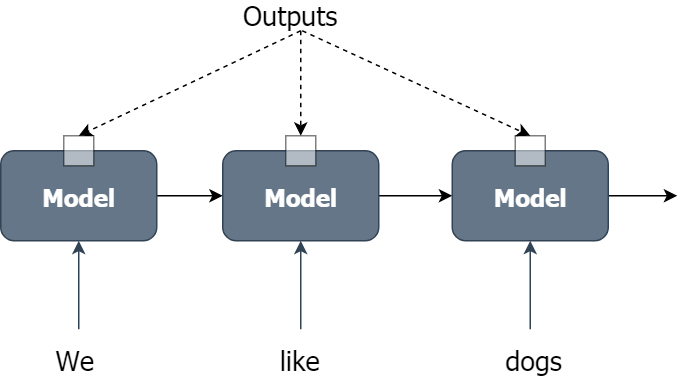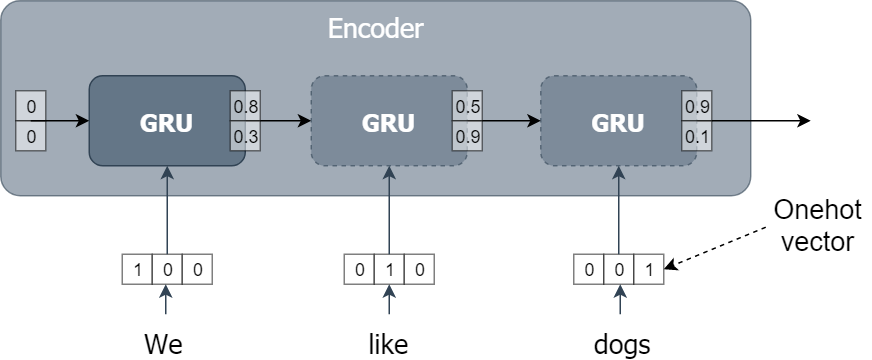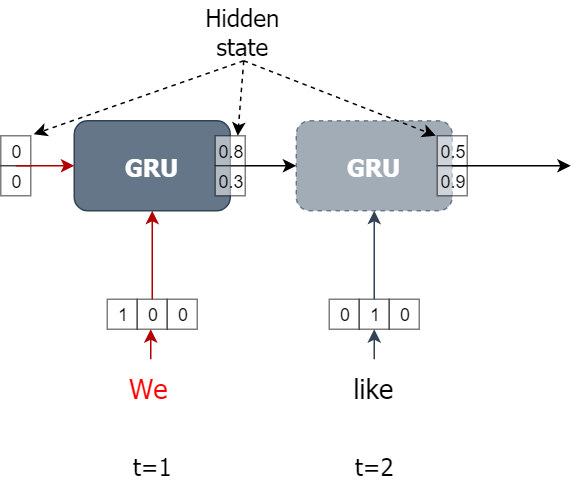Understanding sequential models
Machine Translation with Keras

Thushan Ganegedara
Data Scientist and Author
Time series inputs and sequential models
- A sentence is a time series input
- Current word is affected by previous words
- E.g. He went to the pool for a ....
- The encoder/decoder uses a machine learning model
- Models that can learn from time-series inputs
- Models are called sequential models
Sequential models
- Sequential models
- Moves through the input while producing an output at each time step

Encoder as a sequential model
- GRU - Gated Recurrent Unit

Introduction to the GRU layer
At time step 1, the GRU layer,
- Consumes the input "We"
- Consumes the initial state (0,0)
- Outputs the new state (0.8, 0.3)

Introduction to GRU layer
At time step 2, the GRU layer,
- Consumes the input "like"
- Consumes the initial state (0.8,0.3)
- Outputs the new state (0.5, 0.9)
The hidden state represents "memory" of what the model has seen

Keras (Functional API) refresher
- Keras has two important objects:
LayerandModelobjects. - Input layer
inp = keras.layers.Input(shape=(...))
- Hidden layer
layer = keras.layers.GRU(...)
- Output
out = layer(inp)
- Model
model = Model(inputs=inp, outputs=out)
Understanding the shape of the data
- Sequential data is 3-dimensional
- Batch dimension (e.g. batch = groups of sentences)
- Time dimension - sequence length
- Input dimension (e.g. onehot vector length)
- GRU model input shape
- (Batch, Time, Input)
- (batch size, sequence length, onehot length)

Implementing GRUs with Keras
Defining Keras layers
inp = keras.layers.Input(batch_shape=(2,3,4))
gru_out = keras.layers.GRU(10)(inp)
Defining a Keras model
model = keras.models.Model(inputs=inp, outputs=gru_out)
Implementing GRUs with Keras
Predicting with the Keras model
x = np.random.normal(size=(2,3,4))
y = model.predict(x)
print("shape (y) =", y.shape, "\ny = \n", y)
shape (y) = (2, 10)
y =
[[ 0.2576233 0.01215531 ... -0.32517594 0.4483121 ],
[ 0.54189587 -0.63834655 ... -0.4339783 0.4043917 ]]
Implementing GRUs with Keras
A GRU that takes arbitrary number of samples in a batch
inp = keras.layers.Input(shape=(3,4))
gru_out = keras.layers.GRU(10)(inp)
model = keras.models.Model(inputs=inp, outputs=gru_out)
x = np.random.normal(size=(5,3,4))
y = model.predict(x)
print("y = \n", y)
y =
[[-1.3941444e-02 -3.3123985e-02 ... 6.5081201e-02 1.1245312e-01]
[ 1.1409521e-03 3.6983326e-01 ... -3.4610277e-01 -3.4792548e-01]
[ 2.5911796e-01 -3.9517123e-01 ... 5.8505309e-01 3.6908010e-01]
[-2.8727052e-01 -5.1150680e-02 ... -1.9637148e-01 -1.5587148e-01]
[ 3.1303680e-01 2.3338445e-01 ... 9.1499090e-04 -2.0590121e-01]]
GRU layer's return_state argument
inp = keras.layers.Input(batch_shape=(2,3,4))
gru_out2, gru_state = keras.layers.GRU(10, return_state=True)(inp)
print("gru_out2.shape = ", gru_out2.shape)
print("gru_state.shape = ", gru_state.shape)
gru_out2.shape = (2, 10)
gru_state.shape = (2, 10)

GRU layer's return_sequences argument
inp = keras.layers.Input(batch_shape=(2,3,4))
gru_out3 = keras.layers.GRU(10, return_sequences=True)(inp)
print("gru_out3.shape = ", gru_out2.shape)
gru_out3.shape = (2, 3, 10)

Let's practice!
Machine Translation with Keras

